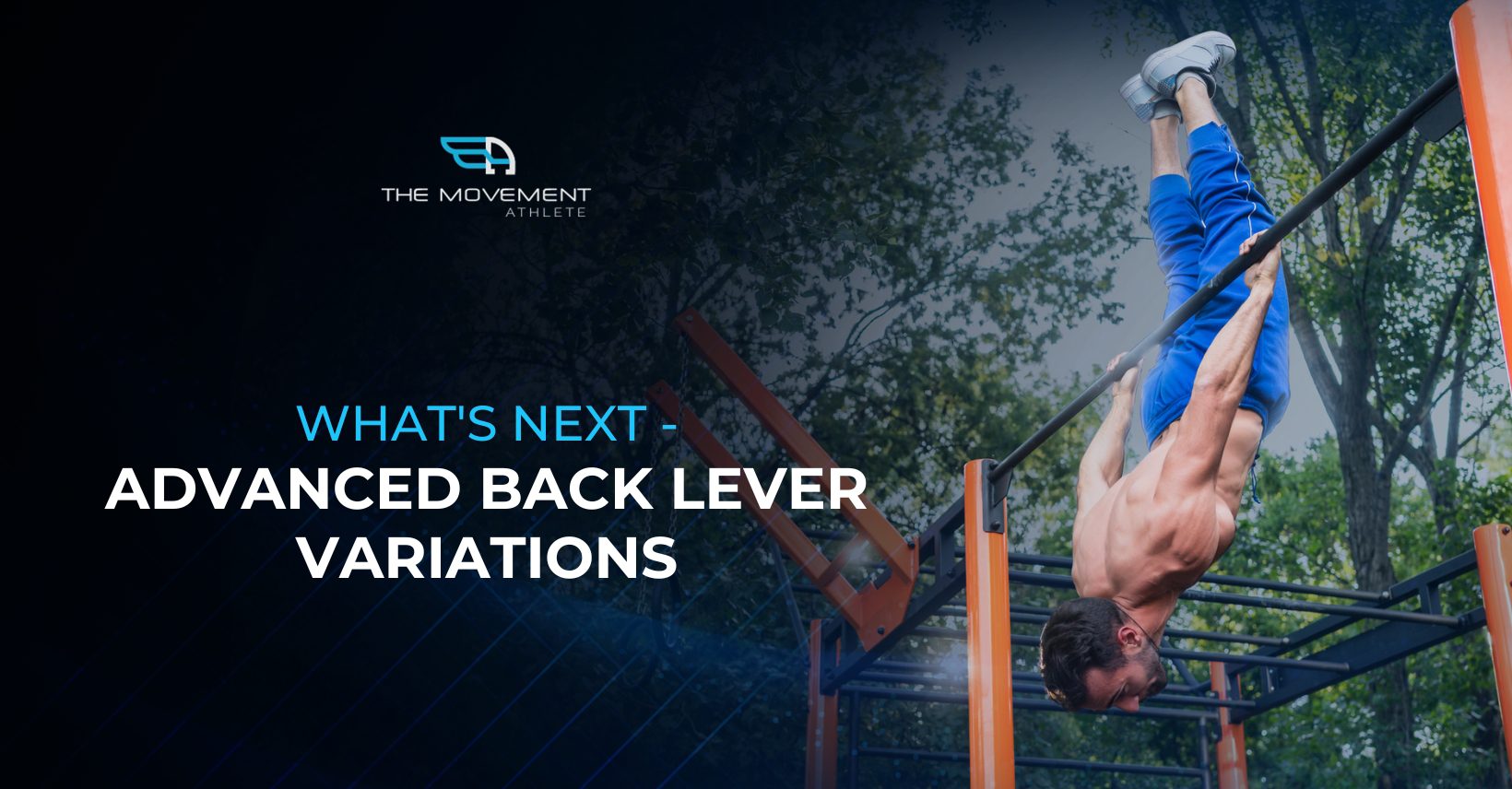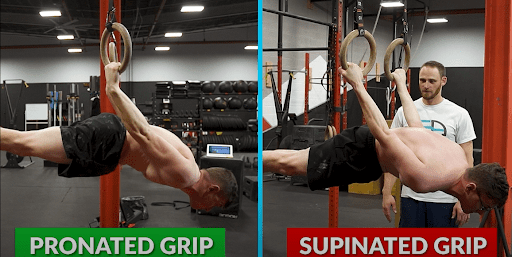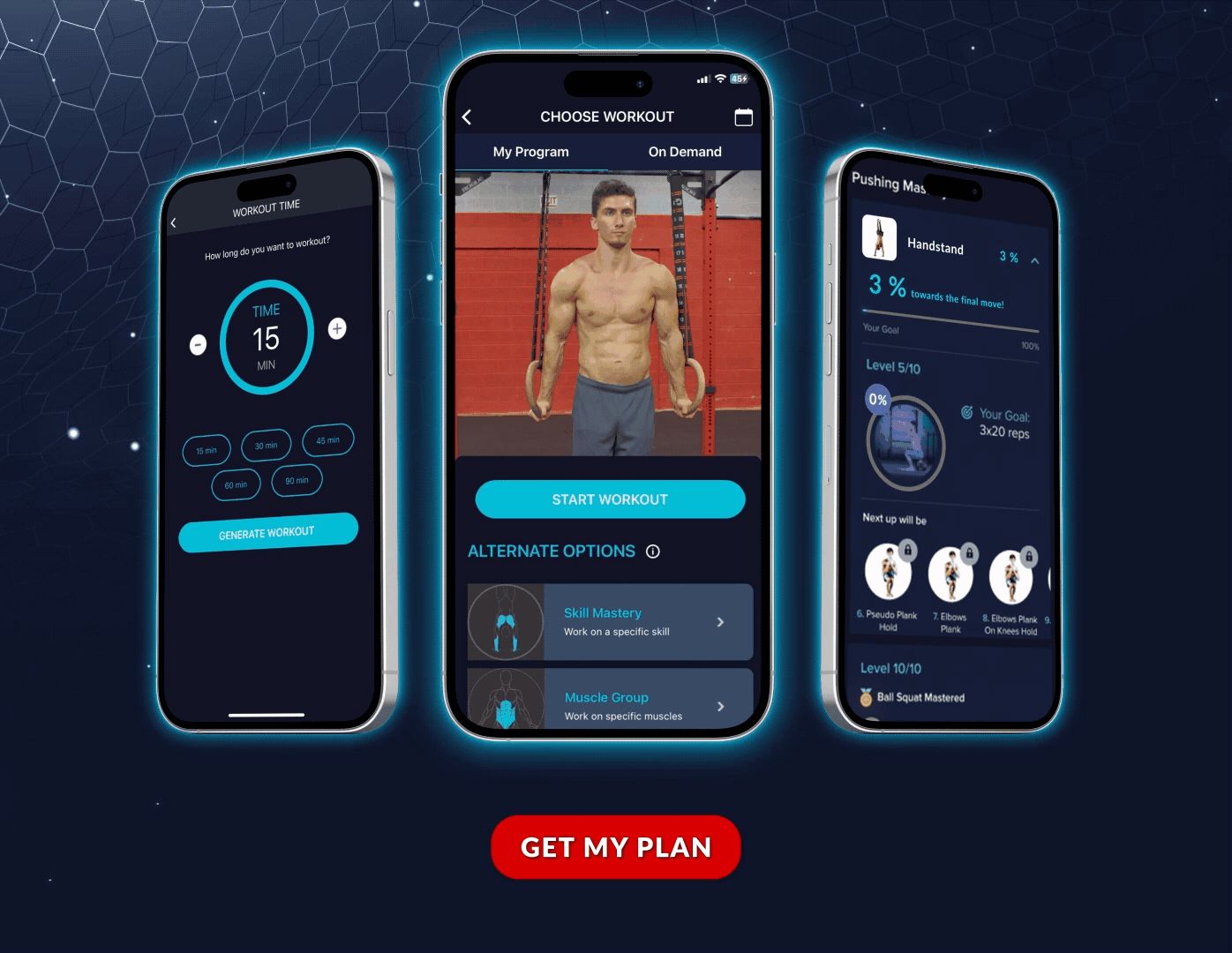

📖 Read Time: 8 Minutes
🏋️ Join the tribe of Movement & Calisthenics Athletes
People just like you that are working with their own body weight to get strength, lose fat, build muscle, recover from injuries and live their best lives!
🎯If you’re an advanced athlete who have mastered the back lever, or if you’re looking to get inspired for more advanced moves, then check out these next-level back lever variations.
All of the exercises in this list require full mastery of the back lever. But more than that, it requires additional training to master these skills below.
These back lever variations and transitions are the top-level exercises.
If you’re ready to get inspired and motivated, then read on! 💪
Back Lever with Supinated Grip

A quick way to raise the intensity of a back lever is to change the grip orientation. In our ultimate guide to the back lever, we teach the exercise with a pronated grip that offers a more accommodating loading unto your shoulders during extension.
When you move your arms into supination in the back lever position, the biceps is further stretched and strained. Allocating more time to straight-arm strength development and bicep conditioning is key to achieve this grip effectively.
If you’ve been able to master a back lever with a pronated grip, don’t be too quick on attempting the back lever with supination. Instead, regress into an easier progression and get a feel in this different grip orientation.
👍How to perform:
1. Begin in an inverted hang.
2. Supinate the arm by twisting the arm so that the palms are facing forward.
3. Slowly lower down in to the horizontal position of the back lever.
4. Hold for time.
⚡️Coaching Pointers
• Protracted and depressed scapula
• Posterior pelvic tilt
• Full body tension
• Straight arms
• Regular body lever position but with supinated arm
🔥Wide-arm/Close-arm Back Lever
Credits: Gaggi Yatarov
One of the advanced variation you can do is to alter your hand width. With a wider stance, you are forced to rely on active tension as compared to a standard shoulder width in which you can place your triceps on your lats for passive tension. In the wide stance, you need more upper body strength to maintain the horizontal back lever.
In contrast, the close-arm back lever requires more mobility. Although you can place your triceps on your lats for assistance, shoulder mobility becomes more of a demand since you need an excellent external rotation.
👍How to perform:
1. Begin in an inverted hang.
2. Lower down into the back lever while moving your hands into a close or wide hand position.
3. Hold for time.
⚡️Coaching Pointers
• Protracted and depressed scapula
• Posterior pelvic tilt
• Full body tension
• Straight arms
• Regular body lever position but with varying hand width
🔥Back lever Pull-up
Credits: @Felix Ng
The back lever pull-up combines straight-arm strength and bent-arm strength while the shoulders extended and behind the back. In this variation, you’re going to pull your body upward towards the rings while maintaining the back lever posture and horizontal line. It’s a very interesting and difficult exercise since you need to push down with your shoulders to maintain the back lever position while pulling upward to execute the pull-up motion.
This challenging exercise requires a much higher level of pulling strength since you need to bend your arms and pull your body upward using only your upper body in a mechanically disadvantageous position.
Training the back lever pull-up is similar to learning the regular back lever. You will need to regress to easier progression such as the tuck back lever when practicing the pulling motion.
For added stability, it’s easier to train the move on the bar since rings tend to swing and move freely. For this reason, the instructions we’re going to provide is based on a bar back lever.
👍How to perform:
1. Enter your back lever position on a bar.
2. Pull your body upward by pushing your elbows outward.
3. Brief pause at the top position.
4. Lower with control back to the back lever.
5. Repeat for reps.
⚡️Coaching Pointers
• Maintain horizontal back lever posture
• Straighten your arm to lockout at the bottom position
• Avoid leading with your lower body when lifting upward
• Move with control to avoid swinging
🔥360 Pull
Credits: @FitnessFAQS
The 360 pull is a combination of a front lever and a back lever done with a full range of motion. In this exercise, you’re going to start from a hang and pull your way to a back lever while maintaining a straight bodyline and lockout arms.
In this complex exercise, you will need to have full scapular control since you have to transition from retraction when pulling into a front lever to an inverted hang to scapular protraction into a back lever.
That being said, aside from a solid back lever, you should also have a solid front lever in your calisthenics arsenal.
👍How to perform:
1. Begin with a dead hang.
2. Retract and depress your shoulders.
3. Pull your body upward into an inverted hang but while maintaining a completely straight bodyline so you can pass through the front lever lane.
4. Shift into a protracted shoulder position instead.
5. Drop your body back with the same bodyline as you pass through the back lever position.
6. Reverse the motion.
7. Repeat for reps.
⚡️Coaching Pointers
• Shift from retraction to protraction and reverse
• Maintain straight lockout arms
• Maintain depressed shoulder
• Keep your body straight
• Full range of motion
🔥One-arm Back Lever
Credits: @JohnMozsarShorts
The one-arm back lever is an incredible display of strength. The back lever alone is already a killer, but performing it with only one hand raises the difficulty not only by two times, but exponentially.
For a balanced development and more impressive feat, always practice one-arm variations on both sides.
👍How to perform:
1. Begin in an inverted hang.
2. Lower down into the back lever position.
3. Remove one arm and hold.
4. Hold for time.
⚡️Coaching Pointers
• Protracted and depressed scapula
• Posterior pelvic tilt
• Full body tension
• Straight arm
• Regular body lever position
🔥Back lever to Maltese
Credits: World Strength Sports
This combination done on rings hails from gymnastics and was popularize by elite gymnast Arthur Zanetti. Because of this, the back lever to Maltese was name after him.
Performing the Zanetti requires two high-level exercises: the back lever and the even much more advanced Maltese. It requires an elite level of pushing strength and straight-arm strength to push from the back lever to Maltese. This is why the move is usually reserved for the few athletes with years of training in their belt.
Just to give you an idea, a Maltese is like a planche, but with your arms slightly wider and your hands leveled with your whole body. This position is incredibly more demanding than the full planche. Performing the move on rings make it even crazier!
A variation of this is pushing from the back lever into the full planche which is still not easy to do.
👍How to perform:
1. While on the rings, enter the full back lever position.
2. Hold for a brief moment.
3. While maintaining a straight and horizontal body line, push down on the rings to elevate your body until you reach the Maltese or Planche position.
4. Hold the top position.
⚡️Coaching Pointers
• Maintain straight lockout arms at all times
• Keep your body full horizontal
• Push through your shoulders to move from the back lever to Maltese/planche
• Full body engaged
📌 Key Takeaway: These advanced back lever variations require complete mastery of the standard back lever first. Don’t rush the progression – even with a solid back lever, these moves will take considerable time and dedicated training to achieve. Trust the process and be patient with your journey!
📌Takeaway
I hope you got inspired with these advanced back lever variations. Anyone who’s willing to do the work with dedication, passion, and consistency can learn them.
But you have to be gradual with the progression and trust the process, because it will be a long journey even if you have already mastered the back lever.
✨Final Words
Congratulations! You just finished reading about advanced back lever variations.
After reading the whole thing, you might want to come back to some points and sections to freshen and remind yourself about the process.
Trust the process. The back lever journey is a long one. It can take time, but you can also speed it up if you follow our comprehensive back lever guide and approach it smartly.
☝️Remember: anyone can learn the back lever!
Ready to take your training to the next level? Take our free calisthenics assessment to get a personalized training plan that will help you master these advanced variations.
Please reach out if you need any additional guidance or support along the way. Thank you for joining us on this journey! 🙏
Related Articles You’ll Love:
Ready to get started?
Get your free personalized training plan now
